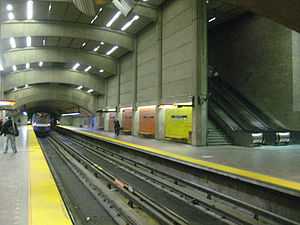Place-Saint-Henri (Montreal Metro)
| Place-Saint-Henri | |||||||||||
|---|---|---|---|---|---|---|---|---|---|---|---|
 | |||||||||||
| Station statistics | |||||||||||
| Address |
555, rue Saint-Ferdinand Le Sud-Ouest, Montreal Quebec, Canada | ||||||||||
| Coordinates | 45°28′38″N 73°35′12″W / 45.47722°N 73.58667°WCoordinates: 45°28′38″N 73°35′12″W / 45.47722°N 73.58667°W | ||||||||||
| Connections |
STM buses | ||||||||||
| Depth | 17.7 metres (58 feet 1 inch), 20th deepest | ||||||||||
| Other information | |||||||||||
| Opened | 28 April 1980 | ||||||||||
| Architect | Julien Hébert & Jean-Louis Lalonde | ||||||||||
| Operator | Société de transport de Montréal | ||||||||||
| OPUS card | vending machine and recharge | ||||||||||
| Traffic | |||||||||||
| Passengers () | 2,141,667 entrances in 2006, 43rd of 68 | ||||||||||
| Services | |||||||||||
| |||||||||||
Place-Saint-Henri is a station on the Orange Line of the Montreal Metro rapid transit system, operated by the Société de transport de Montréal (STM). It is located in the Saint-Henri area of the borough of Le Sud-Ouest in Montreal, Quebec, Canada.[1]
The station opened on April 28, 1980, as the western terminus of the first extension of the orange line. It thus took over from Bonaventure station as terminus, and remained so until the extension to Snowdon in 1981.
Overview
The metro station is a normal side platform station, connected by long stairwells to a large mezzanine. The station has three accesses; one is a conventional access within a bus loop, while the other two are open-air staircases linked to an underground gallery connected to the mezzanine. These make Place-Saint-Henri one of the only three stations in Montreal to have uncovered accesses (with Bonaventure and Square-Victoria stations).
The station was designed by Julien Hébert and Jean-Louis Lalonde. It originally contained two artworks: a mural by Hébert in the mezzanine, entitled Bonheur d'occasion, featuring the title of the famous book by Gabrielle Roy (in English called The Tin Flute), set in the neighbourhood; and a motorized mobile sculpture by Jacques de Tonnancour suspended in the mezzanine and over the platforms.
A statue of Jacques Cartier by Joseph-Arthur Vincent, created in 1896, was moved to the station and placed in a light shaft over the Côte-Vertu platform. It had formerly crowned a fountain in a nearby park, but was removed, moved to the station, and replaced with a copy after having crumbled due to exposure.
Origin of the name
This station is named for place Saint-Henri, a short street and public square between rue Saint-Jacques and rue Notre-Dame. The place and the district took their name from a chapel built in 1810 and placed under the protection of Saint Henry, possibly to commemorate Henri-Auguste Roux (1798–1831), superior of Saint-Sulpice Seminary.
Connecting bus routes
| Société de transport de Montréal | |||
|---|---|---|---|
| Route | Service Times | Map | Schedule |
| |
All-day | Map | Schedule |
| |
All-day | Map | Schedule |
| |
All-day, Weekends before 12:00AM | Map | Schedule |
| |
All-day, Weekends before 12:00AM, Located one block north on Saint-Antoine | Map | Schedule |
| |
All-day | Map | Schedule |
| |
All-day, Located one block south on Notre-Dame | Map | Schedule |
| |
Overnight | Map | Schedule |
| |
Overnight, Located one block north on Saint-Antoine | Map | Schedule |
Parking
There is parking next to the metro provided by the city of Montreal. Monthly passes are available for $63.
Nearby points of interest
- École secondaire Saint-Henri - École des métiers du Sud-Ouest
- Piscine Saint-Henri
- Parc Saint-Henri
- CLSC Saint-Henri
- Parc Sir-Georges-Étienne-Cartier
- POPIR Comité Logement
- Institut technique Aviron
- Parc Louis-Cyr
- Théâtre Dôme
- Musée des ondes Emile-Berliner
Place-Saint-Henri in Popular Culture
Scenes from Denys Arcand's film Jésus de Montréal (Jesus of Montreal) were filmed in this station.[2]
References
External links
- Place-Saint-Henri Station, official web page
- Place-Saint-Henri metro station geo location
- Montreal by Metro, metrodemontreal.com - photos, information, and trivia
- 2011 STM System Map
- Metro Map